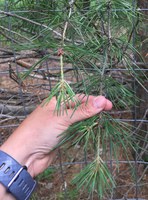Dakota Gardener: The Power of Observation
(Click an image below to view a high-resolution image that can be downloaded)
By Joe Zeleznik, Forester
NDSU Extension
The sky is blue. And tree leaves are green.
Any other statements of the obvious that I should make? My brother likes to say that I have “a keen eye for the obvious.” It’s a family trait.
The sky is blue, except when it’s cloudy, or at sunrise and sunset, when purples, pinks and brilliant oranges fill our vision. Tree leaves are green, except when they’re burgundy, such as in some Norway maples, or variegated green and white such as in ‘Ivory Halo’ dogwood. Young, developing leaves of many deciduous trees actually show a reddish tinge.
What seems obvious at first glance might not be so clear-cut. That’s why observation is so important.
Every year in June, I get dozens of calls and emails about peoples’ trees. They want to know what’s wrong and how to treat the problem. Sometimes, the diagnoses are easy and other times the causes – and solutions – are not so clear.
Last week’s most interesting question came from a county Extension agent regarding a Scotch pine tree. The newly forming twig, or “candle,” didn’t have needles from the base all the way to the tip, like we see on the leader of the tree.
Instead, the twig had a gap of several inches that didn’t have needles or anything at all. It was empty, and the tree had been growing this way for several years. What was going on? And how should we fix it?
I was very excited to get this question because it was an easy one. I knew the answer based on my observations through the years. My response? Nothing was wrong at all!
This is normal growth for older pine trees. That gap is where the tree’s “pollen cones” form every year. The technical term is “strobili.” In the spring, the pollen cones begin to expand at about the same time as the needles, and during the next few weeks, they shed their contents with the goal of producing another generation of trees.
Trees are amazing to observe. They go through the same cycle of growth, senescence and dormancy every year. The timing might be a little bit off from one year to the next, but the general cycle gets repeated again and again.
I was fortunate to observe an outbreak of forest tent caterpillar (scientific name Malacosoma disstria) several years ago. The insects went from eggs to larvae, through pupae and adults and back to eggs again in just 2 1/2 months.
It was amazing. I pulled open some of the cocoons and found a few pupae that were dead, having been parasitized by another insect. As a scientist, I was fascinated.
I would encourage you to go out and observe your trees. Are they producing fruit? What’s feeding on them? Were they planted at the right depth? Make good observations. You’ll discover something exciting.
NDSU Agriculture Communication - June 30, 2020
| Source: | Joe Zeleznik, 701-231-8143, joseph.zeleznik@ndsu.edu |
|---|---|
| Editor: | Ellen Crawford, 701-231-5391, ellen.crawford@ndsu.edu |




